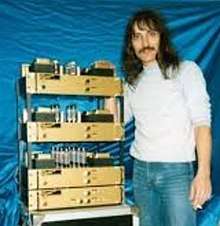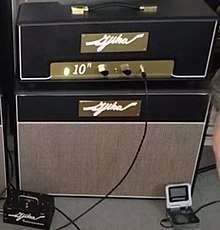Gjika Amplification
 | |
| Private | |
| Industry | Amplification |
| Founded | Boston, Massachusetts, United States (1984) |
| Founder | Robert Gjika |
| Headquarters | Escondido, California, USA |
Key people | Robert Gjika |
| Products | Amplifiers |
| Website |
www |


Gjika Amplification was founded in Boston, Massachusetts in the early 1980s, by Robert (Bob) Gjika. Gjika amplifiers are original designs, and are completely hand-wired. Gjika amps are said by some guitarists to be the finest guitar amplifiers (also known as boutique guitar amplifiers) available.
Origins
Robert Gjika was born in Winthrop, Massachusetts, in 1960. At a young age, he found his love of music, and soon after, began building his own guitars and amplifiers. His father was an electrician, giving him an early start in electronics. Later, he also had older musicians as mentors. His passion in his teens and twenties was playing the guitars he crafted himself, in his various local bands. By 1979, he had established himself in the local Boston area as a Luthier, repairing and building guitars and amplifiers for E.U. Wurlitzer Music and Sound. After a year+ working there, he opened up his own shop in Boston, where he was soon in-demand for all things related to guitars and amplifiers. Some of the musicians and bands he did work for included popular Boston bands at the time, guitarists such as Reeves Gabrels, guitar wizard Joe Stump, and other guitarists from the Berklee College of Music scene.[1]
Relocations
Gjika has lived and worked in several of the larger music cities in the United States. He moved his business from Boston to Memphis, Tennessee in 1987, where he met the late Shawn Lane, and introduced Shawn to his guitars and single-ended amp designs. They enjoyed a meeting of the minds and became close friends. In 1989 he relocated to Los Angeles, California, to focus on producing the "Gold" amps, with a new business partner, Bill Walker, under the brand name "Gjika-Walker". In 1990, after the business partnership was amicably dissolved (Gjika and Walker remain good friends[2]), Gjika left Los Angeles to go to Austin, Texas, where the music scene was flourishing, and at that time, transitioned from his Gold Amps to his 3-Channel KT90 amplifier. In 1996 he again relocated, to Nashville, Tennessee.[3] During these years he continued his amp designing and building, on a smaller scale, until in 2000 he went back to California, where he currently resides and builds his amplifiers in Escondido.
Mission
As a young guitarist, Gjika was dissatisfied by his inability to achieve the guitar tones he was hearing on the recordings of the artists he enjoyed listening to. He realized that these tones were made possible by the work of the recording studio technicians, with the equipment they had employed to alter the original tones coming from the amplifiers. This was further demonstrated to Gjika, as some of his older mentors had their own recording studios, and experience in forcing these amps to sound better on their recordings. Observing the shortcomings of the available amplifiers, Gjika put his knowledge and energy into modifying them. But his modifications failed to satisfy Gjika, as these amplifiers were observed to have intrinsic design flaws which made them unreliable, therefore, not worth the effort and expense to attempt to turn them into what he was looking for. Gjika stopped making modifications to existing amplifiers, and started designing original amplifiers to get better guitar tone, as well as be reliable in the studio and on the road.[4]
The Gjika "Gold" amp fulfilled Gjika's goal of creating an amplifier that would give highly talented guitarists, including the late Shawn Lane, the ability to have similar tone in a live performance that was only previously available from sound studios. But there was still a major problem with this amp: its large size and heavy weight which made it impractical to use for touring and gigs.
Gjika continued with his mission, seeking to achieve this same guitar tone in a smaller, lighter package, and made quite a few more designs, both single-ended and push-pull, but after years of guitarists requesting that Gjika bring his 8-EL34 stereo amp (Gold Amp) back into production, he then focused on re-designing the old Gold into a more user-friendly, portable unit and on improving the tone further. With his Gainmaster, he was able to do this, with the 10^n (Powers of Ten) amp, in 2016.
Public reception
In Memphis, Gjika's Quality Guitars, on Union Avenue, was featured in a local music publication, in which Tim O'Shea said of Gjika's skills: "His technical expertise is most impressive, especially his "diagnosis to repair" knowledge of another rock necessity, the electric PA and amp... Gjika also builds and sells his custom, "Hot Box" amplifiers, perhaps the finest available anywhere." Of Bob's custom guitar designs: "Gjika builds three or four of his custom 'Wild Thing' guitars each year, at a cool five grand apiece. The prototype guitars are truly wonders to behold at any stage of construction."[5]
In 1988, Bob Gjika was featured in a local Memphis news station segment, where he showed some examples of his trendsetting guitar designs in various stages of construction[6] eight months after arriving in Memphis.
Users of Gjika amps post on various music sites, for example, a reviewer of the Gjika KT-90 Tone Monster, in Harmony Central, shares his experience of the Gjika KT-90, insofar as tone quality is concerned; "When cranked this amp sings like no other. And guess what? You can use the treble control. I mean you can crank that dog to the top and still the amp sounds sweet and warm, with just more nice high end. No ear fatigue, just pure tone." Further, on reliability and durability, he states; "The amp is built like a tank. You can not imagine how bullet proof this amp is. It is beyond anything that I have ever seen construction wise." He further commented; "You cannot compare this amp to anything else on the market so I won't. This is a great amp, and Gjika is one of the top amp builders in the world."[7]
Focusing on his own playing, as well as designing and building guitars and amps, Gjika acquired a reputation for being reclusive, resulting in many believing that he had retired from amp building. It was noted by Dave Hunter in his reverb.com article, "Dave's Corner: Guide to Boutique Amps", in which he wrote "This enigmatic amp maker and all-round tech extraordinaire goes to few (if any) lengths to promote his own work." As to the quality of the guitar tone produced by Bob's original design amps, he assessed that "Characteristics of Gjika amps include their thick, rich, harmonically saturated tone and fast playing response." Further, "Bob Gjika has worked with Eric Johnson, but might be best known for the scorching single-ended EL34-based amp that the late and largely underappreciated fusion virtuoso Shawn Lane used on his Powers of Ten...a massive beast with four EL34s (or eight in its stereo configuration) and possibly the largest transformers I’ve seen on a guitar amp, giving it earth-shaking body and tremendous gain."[8]
In an interview by Guitar Player magazine, Shawn Lane referred to his use of his Gjika Gold amp on his album Powers of Ten in glowing terms: "It's class-A power, all-tube, and just one of the most amazing amplifiers I've ever heard. It has a harmonic richness that really responds to a certain kind of touch."[9]
Premier Guitar covered the Premier Builder's Guild's NAMM booth featuring Gjika Amps, with highly positive reception.[10]
Amplifiers and related devices
Amplifiers:
- Gjika Hot Box (the "original" Hot Box - name has been used by others since)
- Gjika Gray amp
- Gjika White amp
- "Gold" 8-EL34 single-ended Amp - AKA the "Shawn Lane" amp
- 4-EL34 Push-pull amp
- 4-KT88 Push-pull amp
- 3-channel - 4-KT90 "Texas" amp
- Dual KT77 amp
- Dual KT66 amp
- 4-EL84L amp
- 2-6v6 push-pull amp
- 2-KT66 push-pull amp
- Single-Ended 1-KT66 tweed combo
- Single-Ended 2-EL34 tweed combo
- Gjika SE30 (for Premier Builders Guild[11]) was never put into production, no authorized units exist.
Other Devices:
- Blue Box (gain pedal)
- White Box (gain pedal)
- Black Box (gain pedal)
- Studio Tube Mic Pre-Amp
All of these models are out of production[12]
Gjika Gainmaster
Getting complex, saturated, rich guitar tones at low volumes has been the focus of Gjika's amp designs, and the Gjika Gainmaster gives the ability of Gjika amps to achieve a driven amp sound, at any desired volume, supplying "bedroom amplifier" volumes, as well as providing the necessary power in situations where high volumes are wanted.[13]
Current Model (2018)

- 10^n (Powers of Ten Redux) Amplifier Head with Gainmaster
- 10^n accessory 2x12 speaker cabinet
- Gainmaster Germanium Fuzz Driver (Pedal)
Worked With
Some of the artists that Bob Gjika has worked with:
References
- ↑ Joe Stump under Gear, references "Bob Gjika Hot Box tube preamp"
- ↑ Gjika, Bob. "Woman Tone - Playing the Fool". YouTube. Retrieved 21 June 2017.
- ↑ "Gjika Custom Guitar & Amplifiers". Manta. Manta.com.
- ↑ Gjika, Bob. "What is the Gjika 10^n, and how is it fundamentally different from every other guitar amplifier?". YouTube. Retrieved 4 August 2017.
- ↑ O'Shea, Tim (July 1988). "The Custom Guitar and Mother Memphis". Memphis Star - The Voice of Memphis Music: 52.
- ↑ Tonefiend. "Bob Gjika making guitars on the Memphis TV news in his 20s". YouTube. Retrieved 11 October 2010.
- ↑ "Gjika KT-90 Tone Monster". Harmony Central. Retrieved 6 May 2001.
- ↑ Hunter, Dave. "Dave's Corner: Boutique Amp Guide Part VIII". Reverb. reverb.com. Retrieved 16 September 2016.
- ↑ Olbrecht, Jas (October 1992). "Shawn Lane, A Cult Hero Surfaces". Guitar Player Magazine: 112.
- ↑ Hammond, Shawn. "NAMM '11 - Fano TC6 & Gjika Amps SE-30 Demos". Premier Guitar.
- ↑ Lovinggood, Jimmy. "Premier Builders Guild 2011 NAMM Booths 2882 & 2883" (PDF). NAMM. NAMM.org. Retrieved 16 July 2010.
- ↑ Gjika, Bob. "Hot Box to 10^n -- A Brief History of Gjika Amplifiers -- 1979 - 2017". YouTube. Retrieved 14 August 2017.
- ↑ Gjika, Bob. "What is the Gjika Gainmaster all about?". YouTube. Retrieved 7 February 2017.
External links
| Wikimedia Commons has media related to Guitar amps. |